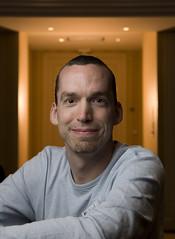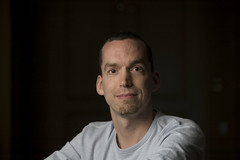 During the shooting portion of last month's seminar I decided to use only found backdrops (i.e., walls, tables, a cool piece of wooden art, etc.) instead of using any of the brought-in items that we had available. The room had some neat angles, and several possibilities, so why not take advantage of them?
During the shooting portion of last month's seminar I decided to use only found backdrops (i.e., walls, tables, a cool piece of wooden art, etc.) instead of using any of the brought-in items that we had available. The room had some neat angles, and several possibilities, so why not take advantage of them?The first one, of attendee Michael, touches on a few points that we have talked about lately. The shot is a good example of lighting on two planes, gelling a backdrop for added color, and using a diffuser to alter the beam of a flash. So I thought I would write it up and expand on the concepts a bit.
(More after the jump.)
Shooting in front of a roomful of people is always a different experience than doing an assignment with just myself and the
Our room in Paris was full of neat opportunities. The first one to catch my eye was a little interior alcove at the doorway. By overpowering the ambient, I could make the room dark. Then, it would be an easy matter to separately light up the two zones I wanted: The alcove and Michael.
During lunch I placed a speedlight in the alcove. To this I added a CTO gel and a bare bulb diffuser (a Sto-fen, in this case.) The former was to amp the already-warm color of the alcove. The latter was to make the light from the flash cover the entire alcove from within it.
I almost never (well, never, actually) use a Sto-fen diffuser on camera. They suck up light, and only really help if you are in very tight quarters with properly white walls and ceilings. But they are great for making a poor man's bare bulb flash.
This turns the flash into essentially an open light bulb, reaching out in all directions. With the CTO gel added, it was even more like a real light bulb, as it was tungsten-colored.
What was the setting? I honestly can't remember. And it really isn't important.
 What is important is that I used my hand to shield the flash from being visible and popped a test frame to adjust my camera to the working aperture. Then it would just be a matter of adjusting the strength of the light on Michael to balance with that.
What is important is that I used my hand to shield the flash from being visible and popped a test frame to adjust my camera to the working aperture. Then it would just be a matter of adjusting the strength of the light on Michael to balance with that.This wide test shot was taken at f/4 at a 500th. So, I knew I would be working at or near f/4 for the portrait. Easy.
So I brought Michael in and stuck an umbrella near him -- very near, actually -- and adjusted the output of the flash to work at my already-chosen aperture. In the end, I darkened he doorway background a little by shifting down to f/5, but that was just a subjective choice. By altering my foreground flash and compensating with my aperture, I could make the BG tone whatever I wanted it to be without walking back there.
For the top photo, I also opened up my shutter some to better capture some of the ambient light, which was also tungsten. I like the spotlight bulbs up there. Kind of a my-favorite-martian thing.
 For reference, here is a frame when the alcove light did not fire. (The flash was asleep.) Using this as an example, you can see how the front light is not influencing the background at all. So the two areas are completely controllable, as they are lit on two planes.
For reference, here is a frame when the alcove light did not fire. (The flash was asleep.) Using this as an example, you can see how the front light is not influencing the background at all. So the two areas are completely controllable, as they are lit on two planes.Because of that, I could really have made the alcove any color I wanted it to be.
 Here is a wideangle setup shot, by Rui M. Leal. You can see just how close the shoot-through umbrella is to Michael. This accomplishes three things:
Here is a wideangle setup shot, by Rui M. Leal. You can see just how close the shoot-through umbrella is to Michael. This accomplishes three things:• Maximizes the power efficiency of the light source.
• Creates a huge, soft light.
• Makes Michael's light fall off long before it contaminates the background.
This is a quickie, no-big-deal, ten-minute portrait -- including setup. It's the kind of thing you can do almost anywhere with just a couple of small flashes, anytime you want.
NEXT: Eke in Paris




0 comments:
Post a Comment